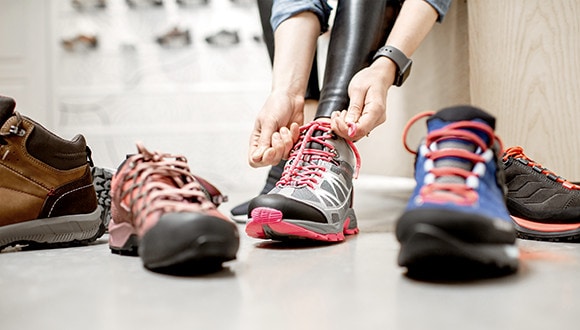Finding the right sports shoe for you
Want to get active but overwhelmed by all the types of sports shoe? Here’s some expert advice on finding the right fit.
Health Agenda magazine
April 2019
There was a time when lacing up for a bout of sport – any sport – meant pulling on your one pair of ‘sandshoes’: all-purpose canvas numbers with rubber soles and grubby white uppers.
These days, thanks to strides in sports science and the acceleration of the sports-shoe industry, your average athletic shoe retailer might offer hundreds of different products including running shoes, walking shoes, training shoes and more. Why are there so many different types, and how do you know which one is right for you?
“Unless you’re going to be spending lot of time doing a specific sport, you should be able to find one shoe that supports you through most of your activities,” says podiatrist Christina O’Brien, a representative of the Australian Podiatry Association.
“For most people who want to exercise a few days a week, get their 10,000 steps a day in and generally build up their fitness, I usually recommend one good all-round running shoe,” she says.
A quality running shoe is your best bet for support at the gym, on the court, walking in the park or pounding the pavement, O’Brien suggests.
“That said, if you’re a competitive netballer or tennis player in regular training, or a distance hiker, activity-specific shoes do have their place,” she adds.

What’s the difference?
Running shoes: A good running shoe has a midsole to support the foot through its phases of movement, robust cushioning in the heel and flexibility through the front of your foot to facilitate movement. Trail running shoes will offer deeper tread for off-road traction, and often some waterproofing.
Walking shoes: Usually heavier than a running shoe, with thinner soles and less cushioning in the heel, walking shoes often will have a leather upper. But “most people will feel more comfortable simply walking in a running shoe,” O’Brien says.
Training shoes: Training and gym shoes tend to be slimmer than a running shoe, with significantly less sole support and cushioning.
“If you’re planning on just doing weights at the gym and not doing a whole lot of aerobic activity, these are probably fine,” O’Brien says. “But they won’t support you properly through boot camp or on the treadmill.”
Hiking shoes: With stiff soles, hardy uppers and a protective toe box to defend against rocky ground, hiking shoes offer varying degrees of high ankle support and waterproofing and are a good investment for those regularly hitting uneven bush tracks or carrying heavy backpacks.
What is pronation?
“Pronation” has long been a pillar of running-shoe selection, with brands and shop assistants emphasising the need to find a shoe that corrects or accommodates your foot arches’ tendency to “roll in” (pronation) or “roll out” (supination). Most of us roll slightly in (neutral pronators), some roll dramatically in (flat-footed over-pronators) and a few roll out when they run (high-arched supinators). But does shoe selection based on pronation behaviour really reduce running injuries?
According to La Trobe University’s Sport and Exercise Medicine Research Centre, there’s no conclusive evidence that any shoe is effective at reducing risk of running injuries. There’s more evidence to suggest that the best way to reduce the risk of injury is to gradually build fitness and training, and tread carefully when changing shoe styles.
If you have specific foot concerns, visit a podiatrist, says O’Brien. “They can tell you if you have any problems with excessive pronation, and point you in the right direction.”
You usually don’t need a referral to see a podiatrist, says HealthDirect. And HCF members on eligible extras cover may be able to get 100% back on their initial consult with a podiatrist in our network through the More for Feet program.
How to find the right sports shoe for you
The best choice of sneakers really depends on your favourite sport and level of intensity. There are cheap and accessible options available if you only plan to wear them occasionally. But if you think you’ll spend a lot of time in your shoe, shopping smart is key: jump, walk and run in a pair of shoes in store and at home to test drive your purchase. Once you’ve found the make and model that works best for you, you can look around for the cheapest retailers.
There are many sports shoes on the market that look great, but fail fast, O’Brien says. Here are 5 signs you should walk away:
- The shoe doesn’t have laces. This is a deal-breaker. It’s not an athletic shoe if it doesn’t lace up.
- You can fold it in half (like a wallet). Some flex in the forefoot is important, but too much suggests the shoe won’t last long.
- You can twist it like a towel. Good mid-foot support should resist sideways flexibility.
- You can fold the back of the shoe down with your thumb.
- The sole is made of extra-light marshmallow-like material. You might feel like you’re walking on a cloud in the store, but lack of support will soon bring you down.
Related articles
TRAVEL: WALKING HOLIDAYS
Explore new places and ramp up your fitness at the same time on a walking holiday.
GETTING FIT AFTER 50: HOW TO FIND YOUR FITNESS MOTIVATION
From training women to tackling trekking adventures around the world and raising millions for charity, Di Westaway is a force to be reckoned with.
EXERCISE DOS AND DON’TS
Stay motivated and reduce your risk of injury with these tips from an exercise physiologist.
IS RUNNING GOOD FOR YOU?
Depending on who you ask, running will either add years to your life or age you prematurely. Here are the facts.